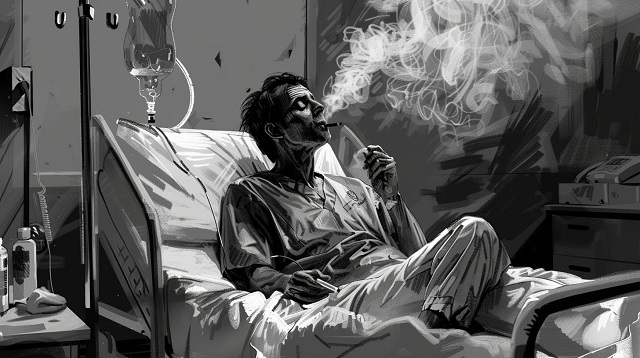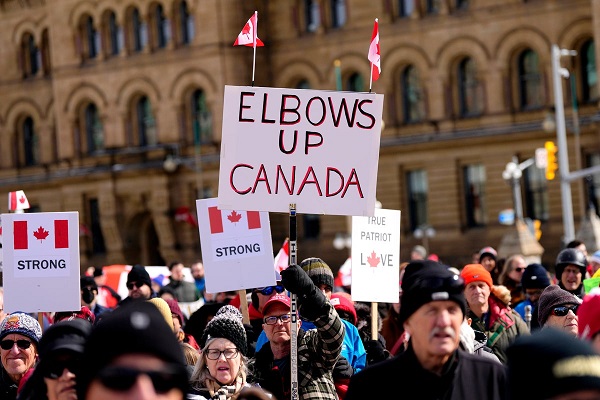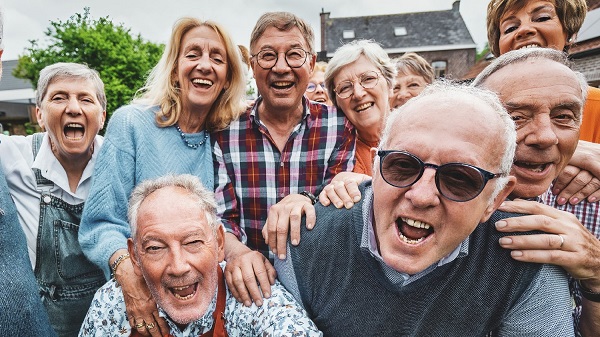Addictions
Illicit drug use still tolerated in some B.C. hospital rooms, says recent patient

Illustration courtesy of Midjourney
News release from Break The Needle
Vancouverite Mark Budworth says he was exposed to illicit drug smoke while recovering from an ankle replacement at St. Paul’s Hospital.
Two months ago, nurses across British Columbia said that the provincial government had allowed addicts to openly smoke illicit drugs, such as fentanyl and meth, in hospital rooms to the detriment of frontline workers and other patients. The province subsequently committed to banning the practice – but testimony from a recently hospitalized patient suggests that, at least in some hospitals, this crackdown may not have been serious.
Mark Budworth is a semi-retired Vancouverite in his early 60s who received a full ankle replacement at St. Paul’s Hospital, one of the province’s preeminent medical institutions, in mid-May. In a recent phone interview, he told Break The Needle that, during his four day stay, he was exposed to illicit drug use that was tolerated by staff and made him feel unsafe.
Though only one story, his account fits into a broader picture of rampant fentanyl trafficking and public disorder that has been bleeding into the province’s healthcare system, all to the seeming indifference of provincial officials.
The problems allegedly began after his surgery when he was wheeled into his hospital room, which was shared with another patient who seemed around 30 years old. “There was a strong smell of smoke. And it didn’t smell like tobacco smoke. It smelled like drugs,” said Budworth, who claimed that the hospital porters transporting him commented on the smell but were largely indifferent to it. To his knowledge, no attempts were made by staff to do anything about the apparent illicit drug use.
The next day, Budworth had a friend visit him. He said that the hospital roommate introduced himself to them and was in a “euphoric” and “confused” state, which made them uncomfortable and led the friend to later speculate that the roommate may have been high on meth. After the friend departed, the roommate allegedly left the room and, upon returning, told Budworth that he had bought $200 of fentanyl.
Subscribe to our newsletter to get our latest news and analysis –
or donate to our investigative journalism fund.
Budworth said that, around midnight that night, he awoke and realized that his roommate, who sounded very intoxicated, was in the middle of an “aggressive” conversation with a female visitor, which sounded “a little scary.” He said the smell of illicit drug smoke lingered in the air and that he called the nurses who, in turn, summoned security guards. As the woman was being removed, security told her to pull her pants up from around her knees, he said.
The alleged incident left Budworth feeling unsafe, as he worried that he might face retaliation from his roommate. The hospital’s nurses refused to relocate him to a new room at first, but eventually relented after he persistently emphasized his safety concerns, he said.
In his second room, his new roommate was a homeless man who would often leave to smoke cigarettes and marijuana, he said. This new roommate allegedly told Budworth that the hospital’s fourth floor rooftop courtyard is an open drug market where people regularly fight and smoke fentanyl.
Budworth said that, throughout the rest of his stay, he spoke with several hospital staff and, though they were “wonderful,” his conversations with them suggested that illicit drug use was tolerated in the building. “The staff didn’t seem to think it was a big deal. It was normal,” he said.
He claimed to have spoken with four nurses, some of whom suggested that illicit drug use among patients was making their jobs difficult. “They’re people dealing with unlimited problems with limited resources,” he said.
After Budworth was discharged from the hospital, he wrote a letter to Health Minister Adrian Dix explaining his concerns, which he then forwarded to Break The Needle. “I’ve read a lot of articles about the nurses complaining. I hadn’t yet read an article about a patient complaining – patients’ experience. And that’s why I thought I should go on record,” he explained over the phone.
The conditions Budworth recalled at St. Paul’s were largely consistent with what was described in a news report published by Glacier Media Group in early April, before the province cracked down on open drug use in hospitals. In that report, a nurse who worked at the hospital told journalist Rob Shaw, “You can barely walk into some of the rooms, there’s needles and broken crack pipes and dirty food all over the floor.”
“Absolutely there are people throughout that hospital who are dealing and using everywhere,” said the nurse at the time. “We know they are drug dealers, and yet they come and go.”
Budworth’s testimony raises concerns about whether the provincial government’s attempts to control illicit drug use in hospitals have, at least in some instances, been unsuccessful.
In an emailed response sent to Break The Needle on May 30, a media representative of St. Paul’s stated that illicit drug use is not permitted anywhere in the hospital, except for an outdoor overdose prevention site (OPS) on the rooftop courtyard, which she said had received approximately 600 unique visits in the preceding two weeks.
The representative wrote that drug trafficking has “never been permitted” anywhere at the hospital, including the OPS. “Security has increased at our sites to support clinical teams as they respond to problematic behaviours, aggression, drug use, and illicit drug dealing in hospitals.”
But apparently those policies neither protected Budworth nor safeguarded his right to a dignified hospital stay free from illicit drugs and intimidating behaviour.
He blamed the province’s failed drug decriminalization experiment, which was recently scaled back by the BC NDP, and said that the decriminalization movement made him feel “uncomfortable” because, “We’re seeing people smoking fentanyl on the streets already… which is easy to walk away from when you’re mobile, but when you’re in a hospital bed and it’s happening in your room, it’s a little too close.”
“I was gonna vote NDP. I think the provincial government’s pretty good, but, with this experience, they lost my vote on this one… I don’t think that our current government and Victoria is really considering all the stakeholders on this issue,” he said.
[This article has been co-published with The Bureau, a Canadian media outlet that tackles corruption and foreign influence campaigns through investigative journalism. Subscribe to their work to get the latest updates on how organized crime influences the Canadian drug trade.]
Break The Needle.
Our content is always free – but if you want to help us commission more high-quality journalism, consider getting a voluntary paid subscription.
Addictions
‘Over and over until they die’: Drug crisis pushes first responders to the brink

First responders say it is not overdoses that leave them feeling burned out—it is the endless cycle of calls they cannot meaningfully resolve
The soap bottle just missed his head.
Standing in the doorway of a cluttered Halifax apartment, Derek, a primary care paramedic, watched it smash against the wall.
Derek was there because the woman who threw it had called 911 again — she did so nearly every day. She said she had chest pain. But when she saw the green patch on his uniform, she erupted. Green meant he could not give her what she wanted: fentanyl.
She screamed at him to call “the red tags” — advanced care paramedics authorized to administer opioids. With none available, Derek declared the scene unsafe and left. Later that night, she called again. This time, a red-patched unit was available. She got her dose.
Derek says he was not angry at the woman, but at the system that left her trapped in addiction — and him powerless to help.
First responders across Canada say it is not overdoses that leave them feeling burned out — it is the endless cycle of calls they cannot meaningfully resolve. Understaffed, overburdened and dispatched into crises they are not equipped to fix, many feel morally and emotionally drained.
“We’re sending our first responders to try and manage what should otherwise be dealt with at structural and systemic levels,” said Nicholas Carleton, a University of Regina researcher who studies the mental health of public safety personnel.
Canadian Affairs agreed to use pseudonyms for the two frontline workers referenced in this story. Canadian Affairs also spoke with nine other first responders who agreed to speak only on background. All of these sources cited concerns about workplace retaliation for speaking out.
Moral injury
Canada’s opioid crisis is pushing frontline workers such as paramedics to the brink.
A 2024 study of 350 Quebec paramedics shows one in three have seriously considered suicide. Globally, ambulance workers have among the highest suicide rates of public service personnel.
Between 2017 and 2024, Canadian paramedics responded to nearly 240,000 suspected opioid overdoses. More than 50,000 of those were fatal.
Yet many paramedics say overdose calls are not the hardest part of the job.
“When they do come up, they’re pretty easy calls,” said Derek. Naloxone, a drug that reverses overdoses, is readily available. “I can actually fix the problem,” he said. “[It’s a] bit of instant gratification, honestly.”
What drains him are the calls they cannot fix: mental health crises, child neglect and abuse, homelessness.
“The ER has a [cardiac catheterization] lab that can do surgery in minutes to fix a heart attack. But there’s nowhere I can bring the mental health patients.
“So they call. And they call. And they call.”
Thomas, a primary care paramedic in Eastern Ontario, echoes that frustration.
“The ER isn’t a good place to treat addiction,” he said. “They need intensive, long-term psychological inpatient treatment and a healthy environment and support system — first responders cannot offer that.”
That powerlessness erodes trust. Paramedics say patients with addictions often become aggressive, or stop seeking help altogether.
“We have a terrible relationship with the people in our community struggling with addiction,” Thomas said. “They know they will sit in an ER bed for a few hours while being in withdrawals and then be discharged with a waitlist or no follow-up.”
Carleton, of the University of Regina, says that reviving people repeatedly without improvement decreases morale.
“You’re resuscitating someone time and time again,” said Carleton, who is also director of the Psychological Trauma and Stress Systems Lab, a federal unit dedicated to mental health research for public safety personnel. “That can lead to compassion fatigue … and moral injury.”
Katy Kamkar, a clinical psychologist focused on first responder mental health, says moral injury arises when workers are trapped in ethically impossible situations — saving a life while knowing that person will be back in the same state tomorrow.
“Burnout is … emotional exhaustion, depersonalization, and reduced personal accomplishment,” she said in an emailed statement. “High call volumes, lack of support or follow-up care for patients, and/or bureaucratic constraints … can increase the risk of reduced empathy, absenteeism and increased turnover.”
Kamkar says moral injury affects all branches of public safety, not just paramedics. Firefighters, who are often the first to arrive on the scene, face trauma from overdose deaths. Police report distress enforcing laws that criminalize suffering.
Understaffed and overburdened
Staffing shortages are another major stressor.
“First responders were amazing during the pandemic, but it also caused a lot of fatigue, and a lot of people left our business because of stress and violence,” said Marc-André Périard, vice president of the Paramedic Chiefs of Canada.
Nearly half of emergency medical services workers experience daily “Code Blacks,” where there are no ambulances available. Vacancy rates are climbing across emergency services. The federal government predicts paramedic shortages will persist over the coming decade, alongside moderate shortages of police and firefighters.
Unsafe work conditions are another concern. Responders enter chaotic scenes where bystanders — often fellow drug users — mistake them for police. Paramedics can face hostility from patients they just saved, says Périard.
“People are upset that they’ve been taken out of their high [when Naloxone is administered] and not realizing how close to dying they were,” he said.
Thomas says safety is undermined by vague, inconsistently enforced policies. And efforts to collect meaningful data can be hampered by a work culture that punishes reporting workplace dangers.
“If you report violence, it can come back to haunt you in performance reviews” he said.
Some hesitate to wait for police before entering volatile scenes, fearing delayed response times.
“[What] would help mitigate violence is to have management support their staff directly in … waiting for police before arriving at the scene, support paramedics in leaving an unsafe scene … and for police and the Crown to pursue cases of violence against health-care workers,” Thomas said.
“Right now, the onus is on us … [but once you enter], leaving a scene is considered patient abandonment,” he said.
Upstream solutions
Carleton says paramedics’ ability to refer patients to addiction and mental health referral networks varies widely based on their location. These networks rely on inconsistent local staffing, creating a patchwork system where people easily fall through the cracks.
“[Any] referral system butts up really quickly against the challenges our health-care system is facing,” he said. “Those infrastructures simply don’t exist at the size and scale that we need.”
Périard agrees. “There’s a lot of investment in safe injection sites, but not as much [resources] put into help[ing] these people deal with their addictions,” he said.
Until that changes, the cycle will continue.
On May 8, Alberta renewed a $1.5 million grant to support first responders’ mental health. Carleton welcomes the funding, but says it risks being futile without also addressing understaffing, excessive workloads and unsafe conditions.
“I applaud Alberta’s investment. But there need to be guardrails and protections in place, because some programs should be quickly dismissed as ineffective — but they aren’t always,” he said.
Carleton’s research found that fewer than 10 mental health programs marketed to Canadian governments — out of 300 in total — are backed up by evidence showing their effectiveness.
In his view, the answer is not complicated — but enormous.
“We’ve got to get way further upstream,” he said.
“We’re rapidly approaching more and more crisis-level challenges… with fewer and fewer [first responders], and we’re asking them to do more and more.”
This article was produced through the Breaking Needles Fellowship Program, which provided a grant to Canadian Affairs, a digital media outlet, to fund journalism exploring addiction and crime in Canada. Articles produced through the Fellowship are co-published by Break The Needle and Canadian Affairs.
Addictions
New RCMP program steering opioid addicted towards treatment and recovery

News release from Alberta RCMP
Virtual Opioid Dependency Program serves vulnerable population in Red Deer
Since April 2024, your Alberta RCMP’s Community Safety and Well-being Branch (CSWB) has been piloting the Virtual Opioid Dependency Program (VODP) program in Red Deer to assist those facing opioid dependency with initial-stage intervention services. VODP is a collaboration with the Government of Alberta, Recovery Alberta, and the Alberta RCMP, and was created to help address opioid addiction across the province.
Red Deer’s VODP consists of two teams, each consisting of a police officer and a paramedic. These teams cover the communities of Red Deer, Innisfail, Blackfalds and Sylvan Lake. The goal of the program is to have frontline points of contact that can assist opioid users by getting them access to treatment, counselling, and life-saving medication.
The Alberta RCMP’s role in VODP:
- Conducting outreach in the community, on foot, by vehicle, and even UTV, and interacting with vulnerable persons and talking with them about treatment options and making VODP referrals.
- Attending calls for service in which opioid use may be a factor, such as drug poisonings, open drug use in public, social diversion calls, etc.
- Administering medication such as Suboxone and Sublocade to opioid users who are arrested and lodged in RCMP cells and voluntarily wish to participate in VODP; these medications help with withdrawal symptoms and are the primary method for treating opioid addiction. Individuals may be provided ongoing treatment while in police custody or incarceration.
- Collaborating with agencies in the treatment and addiction space to work together on client care. Red Deer’s VODP chairs a quarterly Vulnerable Populations Working Group meeting consisting of a number of local stakeholders who come together to address both client and community needs.
While accountability for criminal actions is necessary, the Alberta RCMP recognizes that opioid addiction is part of larger social and health issues that require long-term supports. Often people facing addictions are among offenders who land in a cycle of criminality. As first responders, our officers are frequently in contact with these individuals. We are ideally placed to help connect those individuals with the VODP. The Alberta RCMP helps those individuals who wish to participate in the VODP by ensuring that they have access to necessary resources and receive the medical care they need, even while they are in police custody.
Since its start, the Red Deer program has made nearly 2,500 referrals and touchpoints with individuals, discussing VODP participation and treatment options. Some successes of the program include:
- In October 2024, Red Deer VODP assessed a 35-year-old male who was arrested and in police custody. The individual was put in contact with medical care and was prescribed and administered Suboxone. The team members did not have any contact with the male again until April 2025 when the individual visited the detachment to thank the team for treating him with care and dignity while in cells, and for getting him access to treatment. The individual stated he had been sober since, saying the treatment saved his life.
- In May 2025, the VODP team worked with a 14-year-old female who was arrested on warrants and lodged in RCMP cells. She had run away from home and was located downtown using opioids. The team spoke to the girl about treatment, was referred to VODP, and was administered Sublocade to treat her addiction. During follow-up, the team received positive feedback from both the family and the attending care providers.
The VODP provides same-day medication starts, opioid treatment transition services, and ongoing opioid dependency care to people anywhere in Alberta who are living with opioid addiction. Visit vodp.ca to learn more.
“This collaboration between Alberta’s Government, Recovery Alberta and the RCMP is a powerful example of how partnerships between health and public safety can change lives. The Virtual Opioid Dependency Program can be the first step in a person’s journey to recovery,” says Alberta’s Minister of Mental Health and Addiction Rick Wilson. “By connecting people to treatment when and where they need it most, we are helping build more paths to recovery and to a healthier Alberta.”
“Part of the Alberta RCMP’s CSWB mandate is the enhancement of public safety through community partnerships,” says Supt. Holly Glassford, Detachment Commander of Red Deer RCMP. “Through VODP, we are committed to building upon community partnerships with social and health agencies, so that we can increase accessibility to supports in our city and reduce crime in Red Deer. Together we are creating a stronger, safer Alberta.”
-

 International2 days ago
International2 days agoChicago suburb purchases childhood home of Pope Leo XIV
-

 Daily Caller2 days ago
Daily Caller2 days agoBlackouts Coming If America Continues With Biden-Era Green Frenzy, Trump Admin Warns
-

 Daily Caller2 days ago
Daily Caller2 days ago‘I Know How These People Operate’: Fmr CIA Officer Calls BS On FBI’s New Epstein Intel
-

 Alberta13 hours ago
Alberta13 hours ago‘Far too serious for such uninformed, careless journalism’: Complaint filed against Globe and Mail article challenging Alberta’s gender surgery law
-

 Frontier Centre for Public Policy1 day ago
Frontier Centre for Public Policy1 day agoNew Book Warns The Decline In Marriage Comes At A High Cost
-

 Economy1 day ago
Economy1 day agoThe stars are aligning for a new pipeline to the West Coast
-

 National1 day ago
National1 day agoLiberal ‘Project Fear’ A Longer Con
-

 Censorship Industrial Complex23 hours ago
Censorship Industrial Complex23 hours agoCanadian pro-freedom group sounds alarm over Liberal plans to revive internet censorship bill







